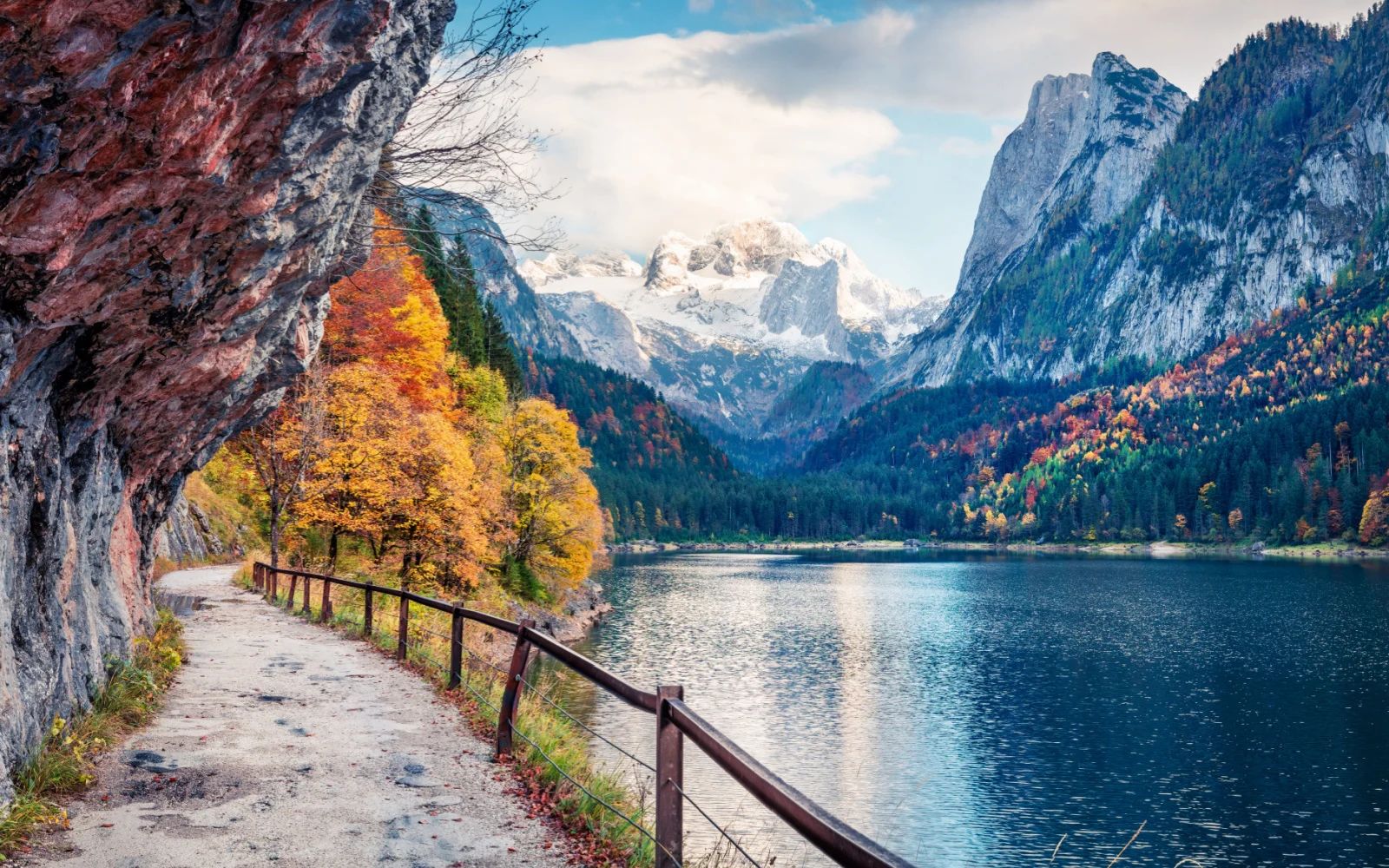Austria is a small European country with less than 33,000 square miles of land. Though it’s slightly larger than Maine, this destination has tons of culture and exciting tourist attractions.
Eight countries border Austria, so you can travel to other European nations during your trip. But what are the country’s best places to see? Don’t worry — we’ll show you this and more in our comprehensive guide below.
The 17 Best Places to Visit in Austria
Austria has something for every type of traveler. You can experience natural beauty, like the Alps and Krimml Waterfall, the tallest waterfall in Europe. Eisriesenwelt is the largest ice cave in the world, stretching about 26 miles.
The Austrian National Library in Vienna has more than two million books and stunning architecture. You can tour Schönbrunn Palace, attend the Salzburger Festspiele opera festival, and experience thrill rides at the Prater, one of the oldest amusement parks.
But that’s not all — here’s a list of our top recommendations for the best places to see in Austria to ensure you make the most of your trip. Let’s dive in!
1. Vienna
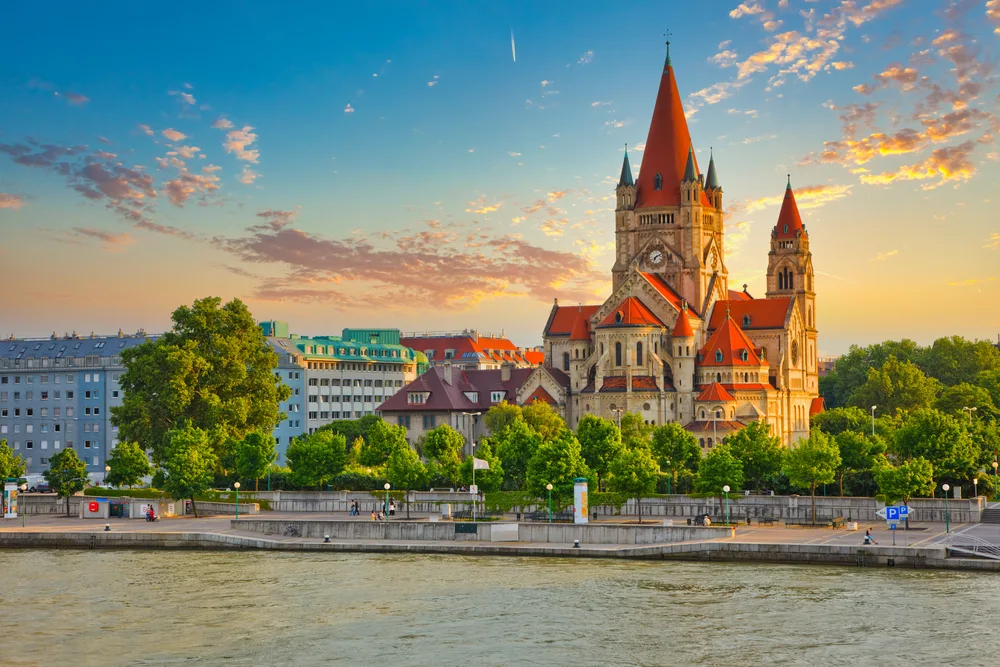
S.Borisov/Shutterstock
Austria’s historic riverfront capital, Vienna, should be at the very top of your list. Stunning cathedrals, museums, and castles rise on the banks of the Danube River here, wrapping you in Austria’s history through its art, culture, and architecture.
Wander the Historic Centre of Vienna to marvel at ornate architecture from the Medieval and Baroque periods alongside 19th-century works. You’ll pass cathedrals, castles with manicured gardens, and buildings lining a massive circular boulevard (Ringstrasse).
Just beyond the “ring road,” you can check out the famous shopping street, Kärntner Straße. It winds past the Vienna State Opera to Stephansplatz square and Stephansdom, one of the world’s tallest cathedrals and a truly stunning sight.
Art appreciators should head to Albertina Museum (drawings and master prints, photography, and architectural history) or the Belvedere Museum for art throughout history from Medieval to contemporary times.
If you love to shop around and immerse in local culture, the Vienna Naschmarkt market features over 100 stalls and booths with produce, delicious food, brews and wine, and unique hand-crafted wares.
You can’t leave Vienna without tasting two of its most famous foods: Weiner Schnitzel (veal cutlets pounded thin, breaded, and fried) and Sachertorte (chocolate layer cake filled with apricot jam and finished with dark chocolate glaze.
Read Next: Where to Stay in Vienna in 2025 & Is Vienna Safe to Visit in 2025?
2. Salzburg
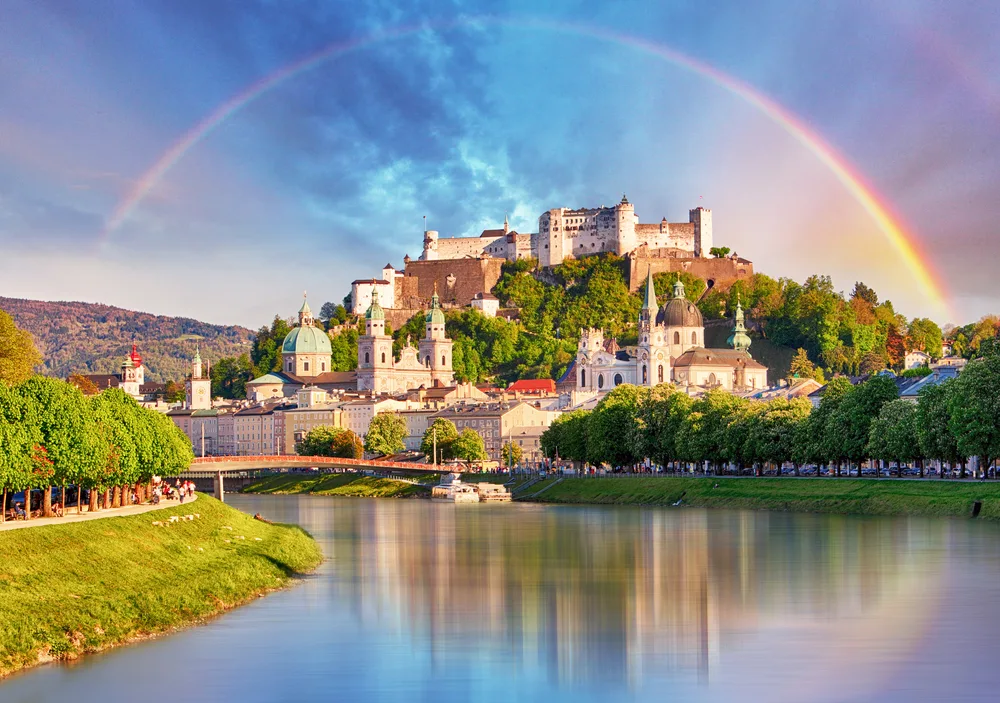
TTstudio/Shutterstock
If you’ve ever wished to visit the location where the Sound of Music was filmed, head to Salzburg. This picturesque, riverfront city has it all: Lush, rolling hills against a backdrop of the rugged Alps, massive castles, and original Baroque architecture.
A guided tour is the best way to take in the city and learn about the history and architecture. Walking tours are ideal, but you can even take a horse-drawn carriage or hop-on hop-off bus tour to see the sights!
Altstadt, or the Old City, sits on the west bank of the Salzach River with the New Town on the east. The Old City is perfect for strolling, while the New Town is ideal to explore, eat, and drink.
You can visit Mozart’s birthplace museum, Mirabell Palace and gardens, and the 17th-century Baroque Salzburg Cathedral here. The nearby mountain-top Hohensalzburg Fortress demands your attention as one of Europe’s largest Medieval castles.
With the Mozart claim to fame, Salzburg knows how classical music was meant to be experienced — in historic concert halls in the Festival District (like Haus für Mozart) and even at cathedrals and palaces around Salzburg for special events.
You can dine at the world’s oldest restaurant, St. Peter Stiftskulinarium, inside St. Peter’s Abbey for an incredible experience (and delicious Austrian fare) in a gorgeous and historic setting.
3. Innsbruck
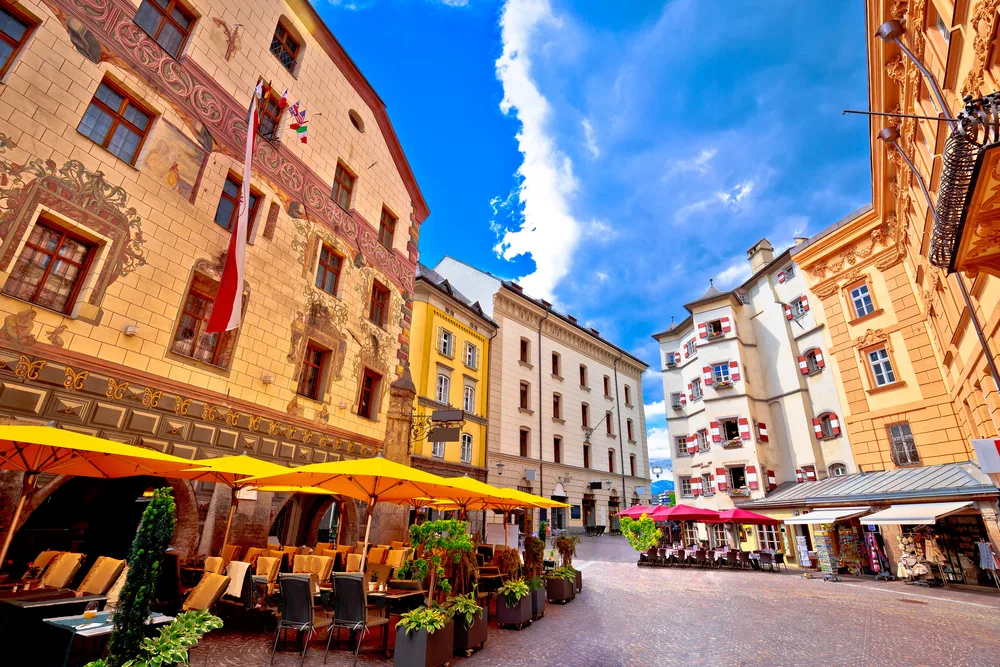
xbrchx/Shutterstock
Vienna and Salzburg are cultural hubs of Austria, but Innsbruck is the destination if you want to get up into the mountains for hiking, scenic vista views, and skiing. The city itself is charming and packed with quaint shops you’ll love perusing at a slower pace.
Innsbruck was established in 1133 and it’s apparent in the cobblestone streets, palaces, museums like Tyrolean Folk Art Museum, historic hotels and guest houses, and tiny shops that line the Old Town alongside the Innsbruck River.
But the real draw to come here is the absolute enveloping presence of the Alps. Innsbruck is ringed by the mountains and those snow-capped peaks are in the background everywhere you look. It’s truly amazing.
Take a cable car from the Old Town up the mountain to check out the Renaissance-era Ambras Castle, an alpine zoo, and Hafelekar at 1.4 miles above sea level for the most incredible views and access to hiking, biking, skiing, and rafting.
But while the magnitude of the Alps is always present, you’ll find yourself fascinated with some of Innsbruck’s small shops that have been here for centuries and cool beer gardens where you can spend an afternoon or evening.
The Speckschwemme (tiny sausage shop) and the Spezialitaten aus der Stiftsgasse (Medieval shop with hundreds of varieties of schnapps and specialty wines) are must-visits. Nearby, the Stiftskeller Augustiner Beer Garden offers brews and authentic bites.
4. Bad Gastein
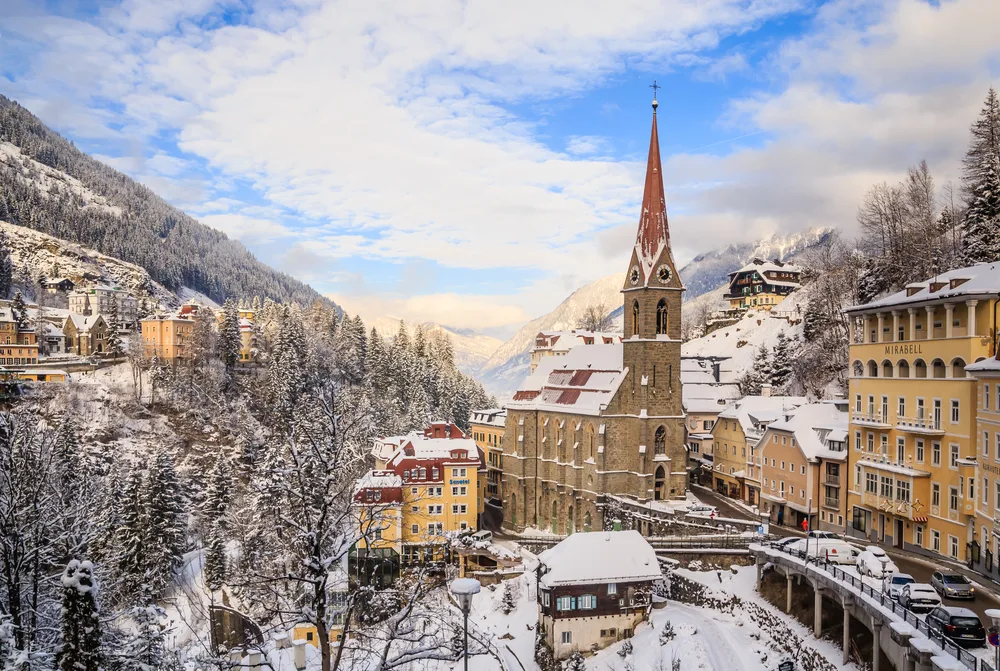
Nikolpetr/Shutterstock
Many people come to Austria to get into the mountains and the picturesque, historic towns that dot the slopes and peaks. Bad Gastein is a charming hot spring and ski town just like this in the High Tauern Mountains just south of Salzburg.
The center of the town is the Gasteiner Waterfall that plunges deep into the valley with mountains rising on either side. Take the Wasserfallweg path to get close to the falls and take in the views.
There are 17 hot springs around Bad Gastein that bubble up with warm, mineral water. Visit the Elisabeth-Spring on a guided tour and take a dip in winter, when it’s especially nice after a day at one of the luxe ski resorts here.
When you look around, you’ll see palatial villas and hotels that are built right into the cliffside at an amazing 3,300 feet above sea level. Imagine staying at a hotel this high and waking up to these views.
You’ll visit the 15th-century St. Nicholas Church to see the larger-than-life Gothic-era frescoes adorning the interior and one of Austria’s oldest stone pulpits inside.
No visit is complete without a stop by the Gasteiner Museum to learn about the discovery of the local hot springs in the 7th century and famous people who’ve visited throughout history.
5. Linz
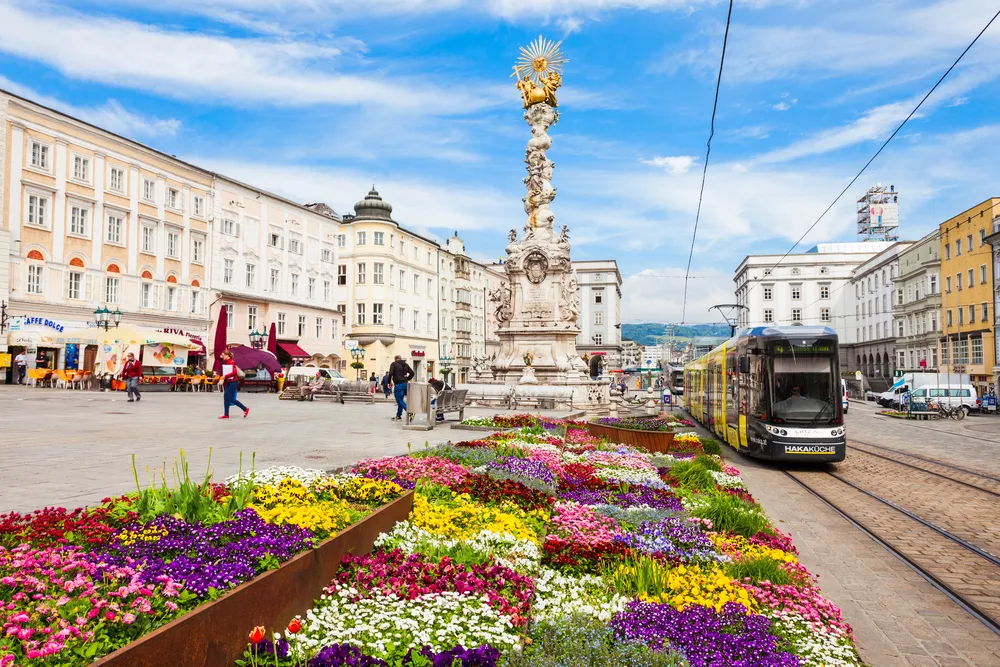
LINZ, AUSTRIA – MAY 15, 2017: Holy Trinity column on the Hauptplatz or main square in the centre of Linz, Austria. Linz is the third largest city of Austria/Saiko3p/Shutterstock
Linz sits near Austria’s northern border with the Czech Republic and is a small, green, and easily-walkable city with its own Medieval castle and Old Town, a bustling square, and a thriving urban art scene.
The main square is the center of town and sits next to the mighty Danube River. Here, you can pop into small shops, markets, and restaurants to taste authentic Austrian dishes and drinks as you make your way down the old brick-paved roads.
The Mural Harbor Gallery is a must-see for visitors, home to the biggest collection of graffiti murals on old buildings along the train tracks that follow the riverfront.
Head to the Ars Electronica Center, “The Museum of the Future,” to see contemporary art combined with technology. Admire the Neo-Gothic St. Mary’s Cathedral (or New Cathedral) and its stunning stained-glass windows.
Linz is much smaller than Vienna or Salzburg with fewer cultural sights to see, but it does have great public transportation and some nightlife to offer. If you love to walk and wander or enjoy green spaces in the city, you’ll feel right at home here.
6. Wachau
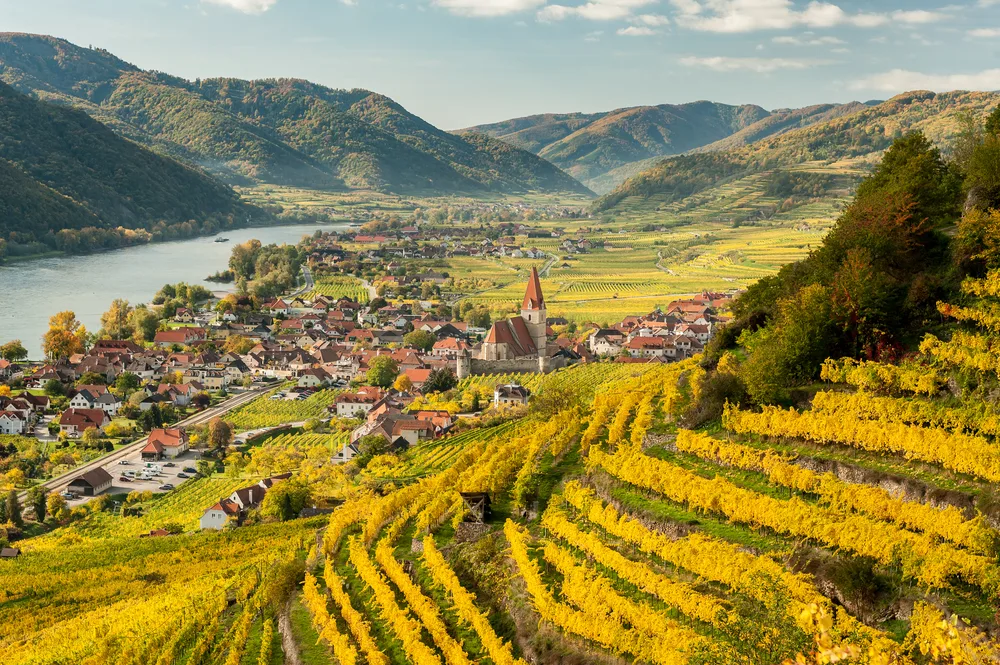
Stefan Rotter/Shutterstock
Wine lovers, you can’t miss the vineyards and wineries of Wachau in the Wachau Valley of Austria. Sitting on the Danube River, this town is the heart of Austria’s wine country and the river feeds its thriving vineyards for distinctly tasty regional wines.
Apricots and grapes grow hardily here with the town’s own appellation system that grades and marks wines grown at different terrace levels in Wachau. Higher terraces produce the best wines, while the lowlands grades are slightly, erm, lower.
You’ll be able to taste your way through dozens of renowned wineries here, sipping regional favorites like Smaragd and Feiderspiel at places like Weingut Knoll, Domaine Wachau, and Weszeli. Book ahead for tastings.
The very best way to tour the rolling, terraced scenery of Wachau’s vineyards is by renting a bike. You’ll ride through the hilly land and see the vast agricultural region of the valley as you pedal past.
For historic sights and a bit of culture, head to the Renaissance-era Schallaburg Castle just outside of Wachau, hike out to the Durnstein Castle ruins for scenic views of the valley, and check out the monasteries here: Melk, Göttweig, and Durnstein Abbeys.
7. Graz
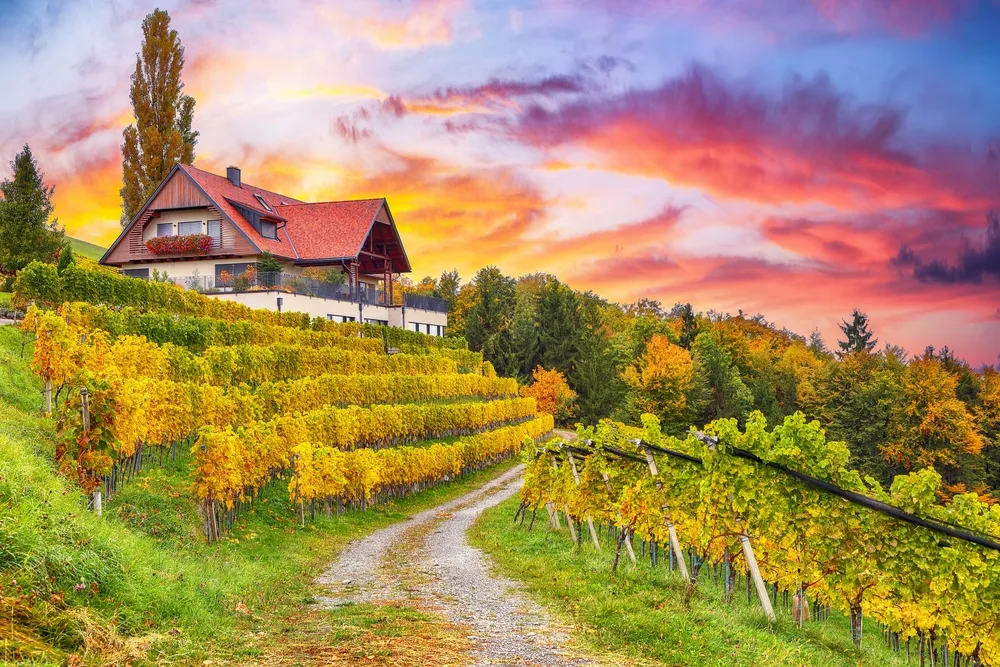
Vadym Lavra/Shutterstock
Graz is located in (and the capital of) the forested and rugged southeast Austrian region of Styria. This mountainous city sits on the River Mur with Schlossberg hill just behind it.
People come to Graz for wine (there are lots of vineyards here), to see old castles and architecture, and to visit luxurious spas. You’ll spot examples of Baroque and Renaissance-era buildings in the city along with contemporary styles that bring you into the present.
Take the funicular up Schlossberg hill to see the 16th-century Uhrturm clock tower that towers over the town. You’ll have great views of the surrounding mountains and vineyards from this vantage point.
Schloss Eggenburg, the region’s most famous and largest Baroque-era palace, is great for a sunny day visit to tour the opulent rooms, gardens, and art gallery onsite.
Spending a day in the city might mean browsing the contemporary Kunsthaus art museum, an architectural wonder in itself with a facade that reminds you of bulging bug eyes.
There’s a man-made island in the river, Murinsel, that’s built with steel and glass to look like a stadium of sorts. Inside, there’s a theater and cafe. The whole thing is illuminated at night for spectacular displays of color and light.
8. Alpbach
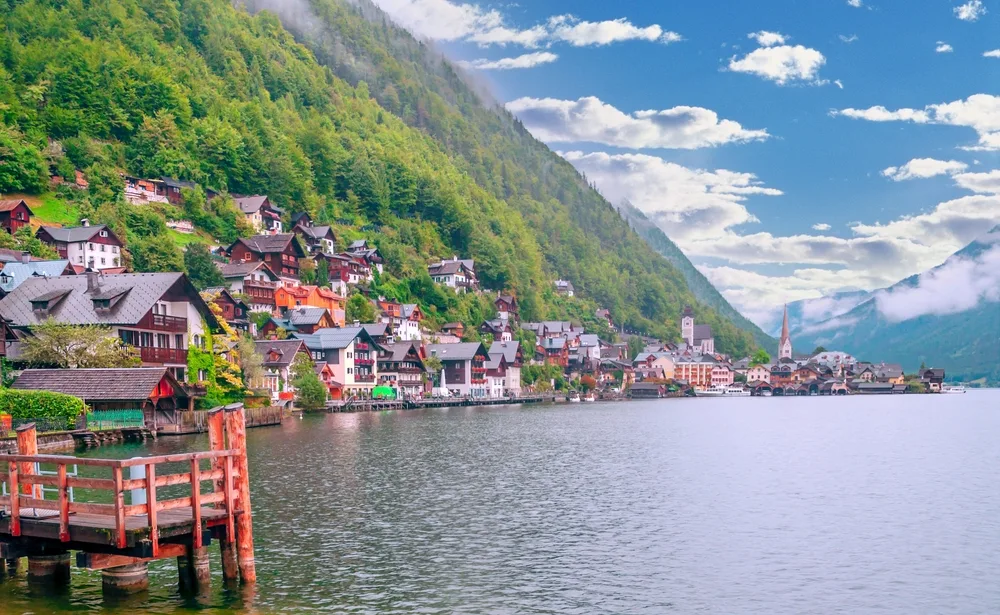
GranTotufo/Shutterstock
For outdoor recreation whether it’s sunny and warm or cold and snowy, look no further than the rustic Alpbach village. Widely known as one of Austria’s most breathtaking areas, this gorgeous spot is ideal for getting outdoors and enjoying nature.
The village of cute, wooden Alpine-style homes is built into the foothills of Mt. Gratlspitz alongside the namesake Alpbach River. With its unique alpine and coastal feel, you can spend time here in any season.
Flowers, birds, and activities like hiking, biking, swimming, and boating will greet you in the warm spring and summer months in Alpbach.
Winter sees opportunities to ski, snowboard, and ride the seasonal Lauser-Sauser alpine coaster at the top of the mountain. Getting to the top is convenient with three train stations that bring you to Ski Juwel Alpbachtal Wildschönau ski area with 70+ miles of slopes.
Be sure to visit Zottahof to try Kaiserschmarren (sweet omelette with cranberries and powdered sugar) and Löffelmilch (a sweet alcoholic milk drink).
9. Danube-Auen National Park
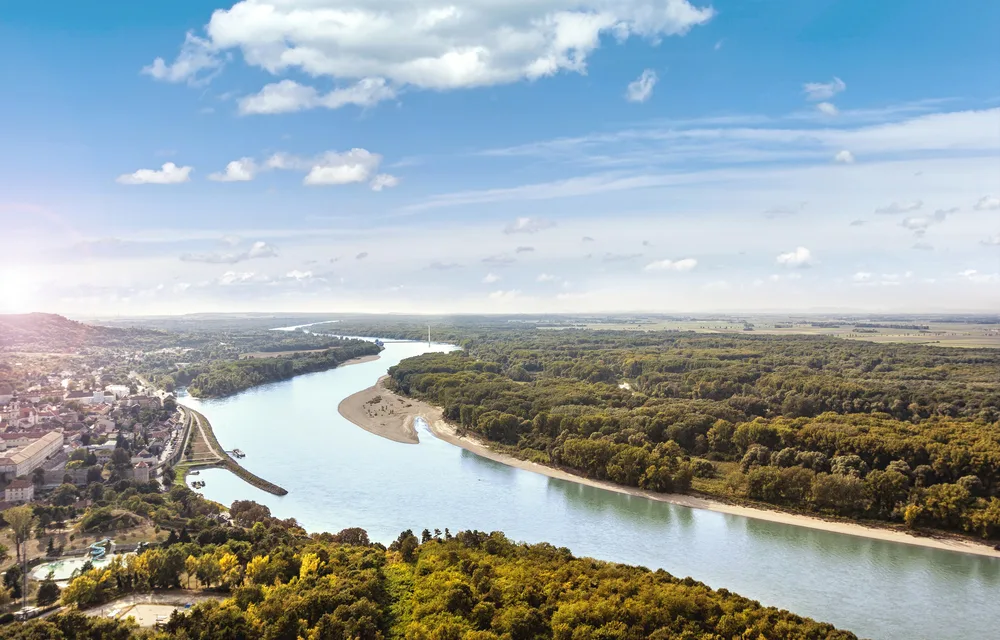
Creativemarc/Shutterstock
The Danube-Auen National Park (or National Park Donau-Auen in German) sits in Lower Austria and Vienna, covering almost 36 square miles of the Danube River, its wetlands and floodplains, meadows, forests, and small islands.
This park opens seasonally between March and November (outside of these months, snow and ice make it inaccessible). During these months, people come to explore the Danube’s wetlands and wildlife in a serene and undisturbed environment.
Start your visit at the schlossORTH National Park Centre to see seasonal exhibits, learn about the park’s formation and history, and grab a map. This park is big on getting people involved in conservation, offering ranger-led hikes, classes, and studies you can join in.
You’ll see tons of wildlife in the park, including 30+ mammal (like Eurasian beavers), 100 bird (like the Eurasian kingfisher), 13 amphibian (like the Danube crested newt), and 8 reptile (like the European pond turtle) species.
Adventure hikes, boat excursions through the park, multi-day camps and camping trips, and wildlife excursions are offered by the park to make your visit complete.
10. Krimml Waterfalls
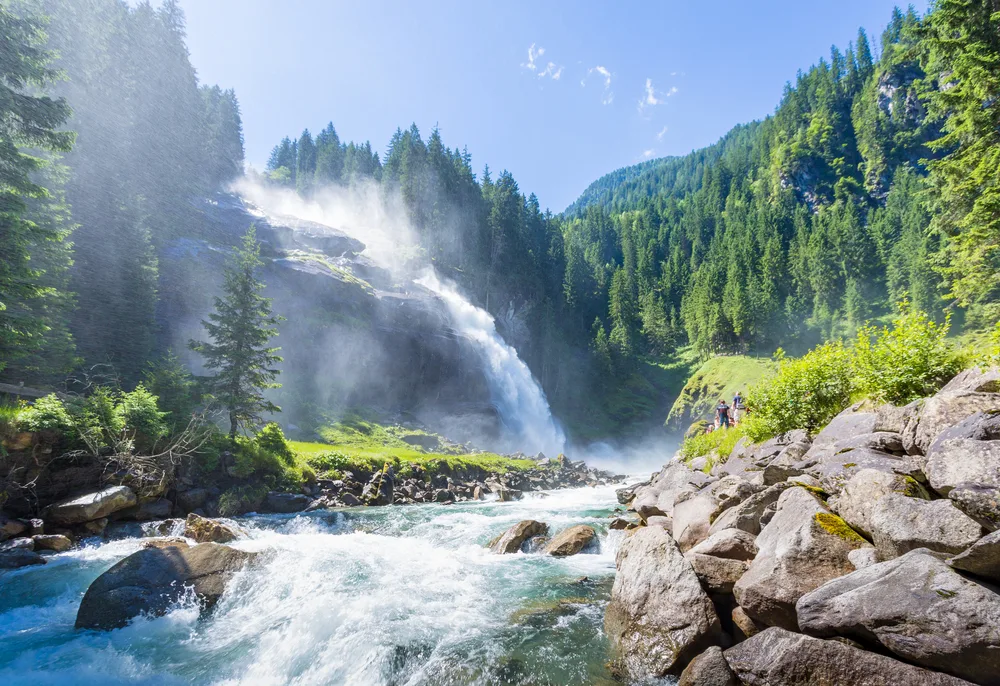
mRGB/Shutterstock
One of the major draws to Austria is its natural beauty and diverse landscapes. You’ll find the highest mountainside waterfall in Europe here at Krimml Waterfalls, plunging a total 4,800+ feet into the Krimmler Ache River near Salzburg.
These tiered waterfalls begin at the top of the Krimmler Ache valley and continue on in a series of cascades that follow the lay of the land in three levels before hitting the river below.
You’ll take it all in while surrounded by evergreen forests filled with pine trees, rocky river banks, and the thundering sound of roaring water as it plummets into the fast-moving river.
You can hike to the lowest fall in just 10-15 minutes if you’re here for a day trip, or opt for the longer, more challenging hike to the top of the falls over a 3-4 hour period for the most scenic views.
You’ll find the trails accessible beginning in mid-April with snow and ice making things difficult come late October.
11. Lake Constance
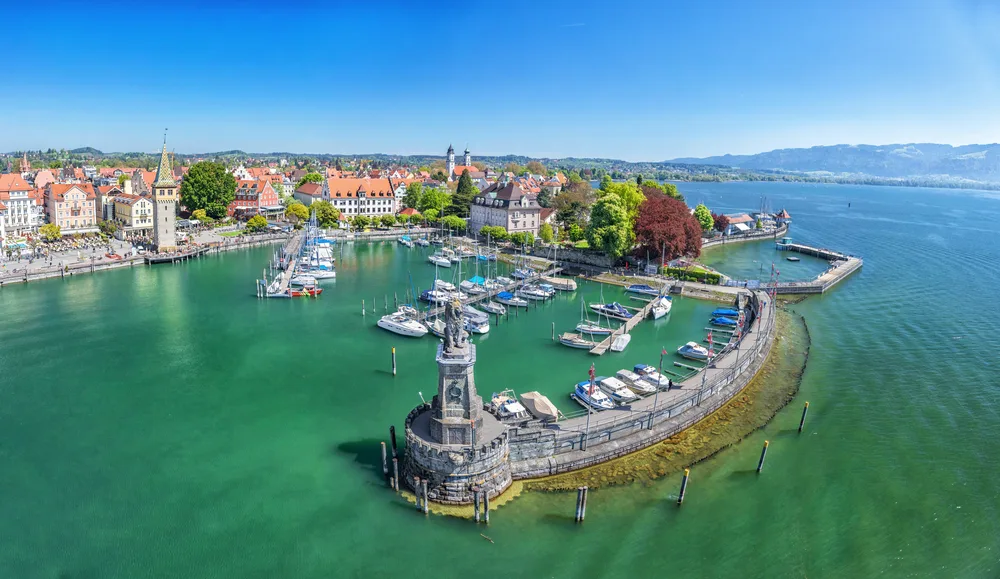
Sergey Dzyuba/Shutterstock
Lake Constance makes a great day trip in Austria, especially if you’re planning on visiting Germany or Switzerland. The three lakes (Upper Lake Constance, or Obersee, Lower Lake Constance, or Untersee, and Lake Rhine, or Seerhein) sit at the border of all three countries.
With the majestic, snow-capped Alps in the distance, amazing architecture and landmarks, and emerald-colored waters all around, you’ll be whisked away in this enchanting place.
Apple farms, bustling markets, hiking trails, a biking trail loop, impressive 7th-century castles, and the 12th-century Mangturm fairytale-esque tower in nearby Germany offer fun ways to get out and explore around the lakes.
Archaeologists have uncovered Paleolithic-era artifacts around the lakes, leading to further discoveries of Neolithic villages and underwater stone mounds around Upper Lake Constance. Visit the Pile Village Museum to learn about the history!
Lots of warm-weather and holiday-themed festivals happen throughout the year at Lake Constance. There’s always something to do and see.
12. Grossglockner High Alpine Road
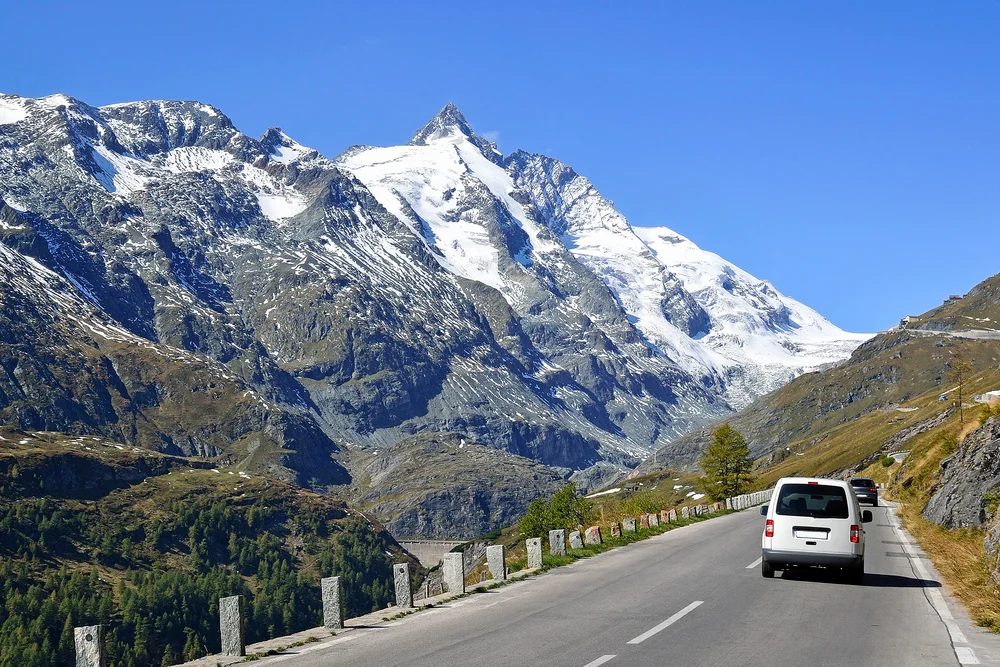
Laszlo66/Shutterstock
If you can’t get enough of Austria’s jaw-dropping views and scenery, take the thrilling Grossglockner High Alpine Road. This scenic drive takes you past some of the country’s most impressive landscapes with 36 winding turns and steep ascents.
The road is named for the black mountain, Grossglockner, that it traverses and it connects from Salzburg to Heiligenblut in Carinthia and can be traveled by car, bus, bike, or motorcycle. Its highest point sits around 8,200 feet!
Grossglockner High Alpine Road leads into the heart of High Tauern National Park, the largest in all of Austria that covers parts of Salzburg, Carinthia, and Tyrol.
Watch the Alps pass by your window as you meander down the road, seeing wildflower- or snow-blanketed meadows, rocky cliff edges, and the undulating topography of rugged mountains as you climb higher.
With lots of overlooks along the way, you can stop off at the most picturesque points and see for miles over the mountainous, wild terrain in front of you.
At the very top, you’ll come to Kaiser-Franz-Josefs-Höhe. Here, you’ll find a visitor center, observation tower, restaurants, and amazing opportunities to view wildlife like golden eagles, marmots, and chamois.
The road typically closes between November and mid-April, so be sure to check before you plan to head this way.
13. Klagenfurt
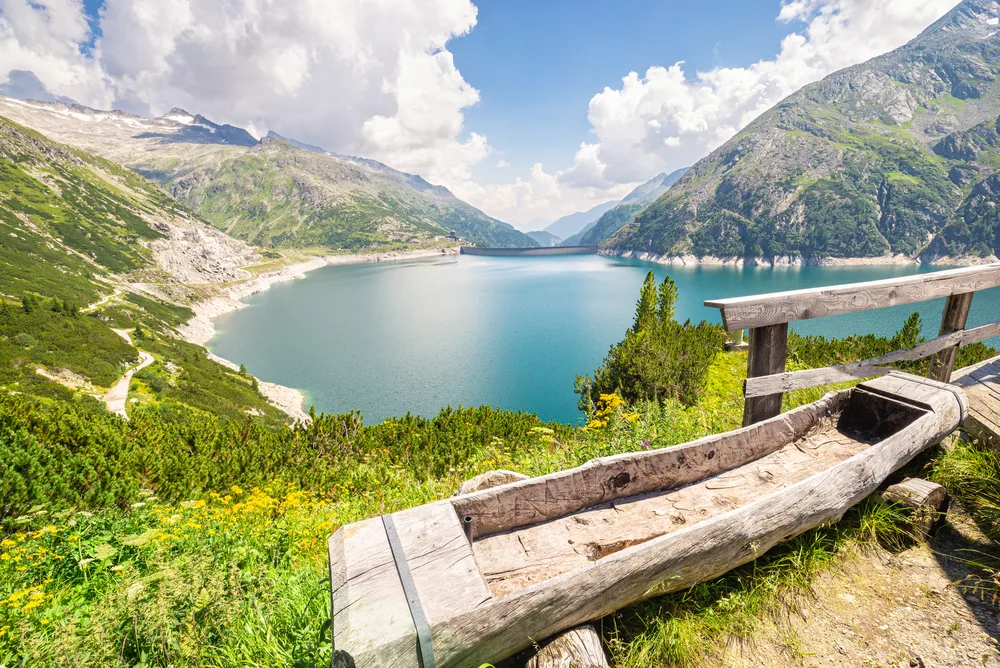
Menno van der Haven/Shutterstock
The drive down Grossglockner High Alpine Road and into High Tauern National Park will put you close to Klagenfurt, one of Austria’s gems and the capital of the Carinthia province.
This city sits on the eastern edge of Lake Wörthersee with impeccable views of Grossglockner (“Black Mountain”) and alpine lakes, forests, and valleys. You’ll feel like you’re high up in the clouds in Klagenfurt.
Get a glimpse of Austria’s culture by exploring the town, where you’ll find the 16th-century Klagenfurt Cathedral decorated with amazing reliefs and frescoes and the massive Lindwurm Fountain featuring a winged dragon in the Neuer Platz square.
Klagenfurt’s Palais Rosenberg (the old town hall) was built in the 17th century and still stands today, canary yellow and impossible to miss. Other Baroque and Renaissance architecture can be seen around Alter Platz.
Head 20 minutes out via train from the Launsdorf-Hochosterwitz train station to see the Medieval Hochosterwitz Castle, built high up on dolomite rock and standing nearly 2,200 feet above sea level.
14. Vienna Woods
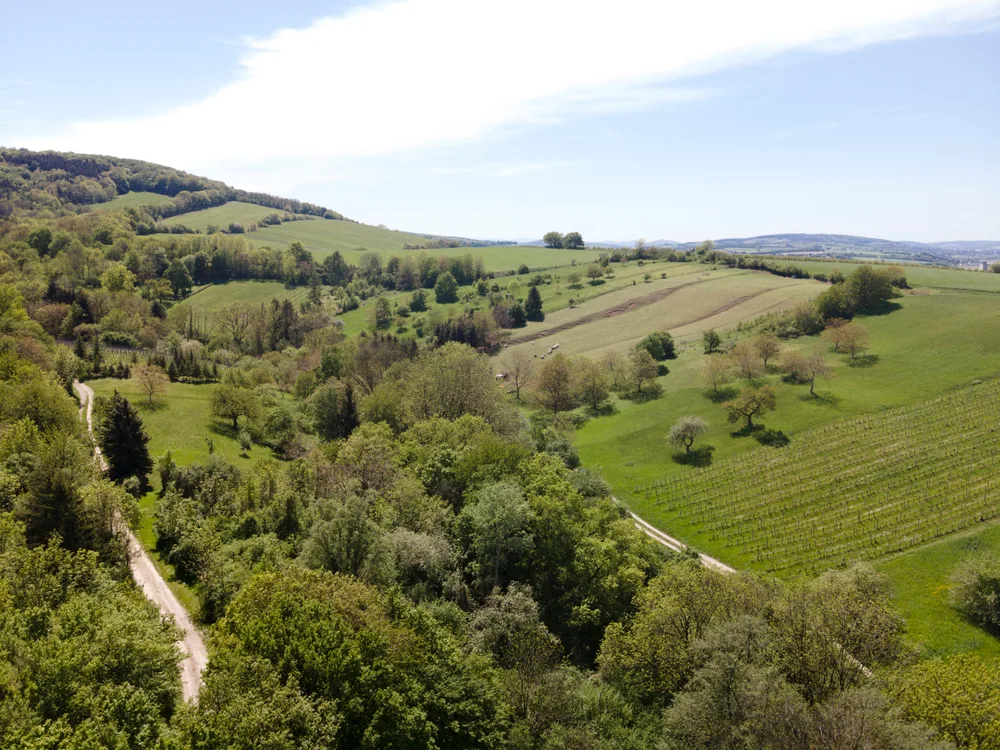
Epiximages/Shutterstock
In the heart of Lower Austria in the foothills of the Alps are the vast, forested, and river-traversed Vienna Woods. The massive area is a UNESCO biosphere reserve that includes the city of Vienna, 15 nature reserves, and 4 national parks.
Known as the “Green Lung” of Vienna and Lower Austria, this protected space is focused on conservation and preservation of animal and plant species in the area. Meadows, rivers, vineyards, hiking and biking trails, lakes, and pastures fill its boundaries.
Inside the reserve, you can visit the Laxenburg Palace grounds with gardens, playgrounds, Blauer Hof Palace, and the Medieval old castle, Altes Schloss. Take a boat ride on the pond while you’re here!
Hike out to the Leopoldsberg and Kahlenberg mountains to reach the famed Stefaniewarte overlook. Here, you can see Vienna and the distant Rat and Schneeberg mountains.
Head into the walled Sparbach Nature Park in the southern end of the Woods to discover ruins, massive old-growth trees, Vienna woodlands and meadows, and free-range wild boars on the property.
The Klosterneuburg Monastery and Heiligenkreuz Abbey (still inhabited) are amazing sights in the Woods, with the latter being the oldest continuously occupied Cistercian monastery anywhere in the world.
Reaching the different destinations in the Vienna Woods is easy by train (Vienna S-Bahn commuter train and Badner-Bahn tram train, for example).
15. Vienna State Opera
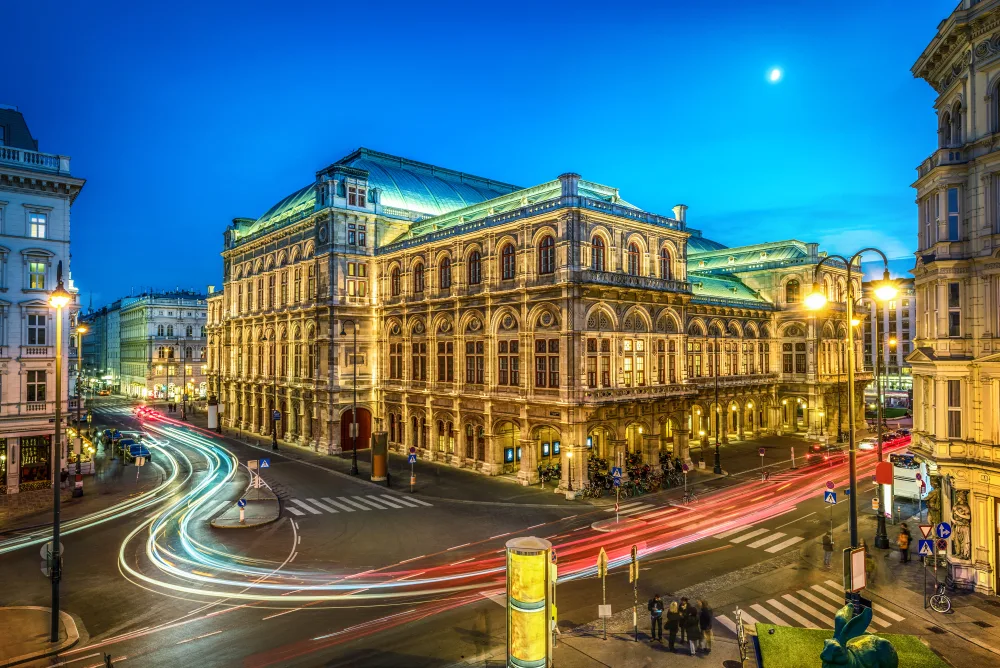
Triff/Shutterstock
The Vienna State Opera was built in 1869 in the Renaissance-Revival architectural style and still acts as the city’s hub for musical and dance entertainment of a higher caliber. Each year, 60+ ballets and operas are performed within its walls.
The Vienna State Opera is pure opulence with beautiful touches both inside and out. The grand staircase, dazzling chandeliers and lighting, archways, pillars, and intricate detailing on the walls wrap you in a sense of finery.
Inside, there’s a cafe and shop where you can buy souvenirs. Snuggle into a reading corner in the Opera Foyer while you wait!
You’ll want to grab tickets for a show (or two) while you’re in Vienna, but to take it a step further, come for a guided tour of the facility. You can learn about the opera house’s history and go backstage for a unique performer’s perspective.
Tours last 40 minutes and take you up the grand staircase and into the 4 state rooms upstairs, then into the auditorium and stage area.
16. Eisriesenwelt Cave
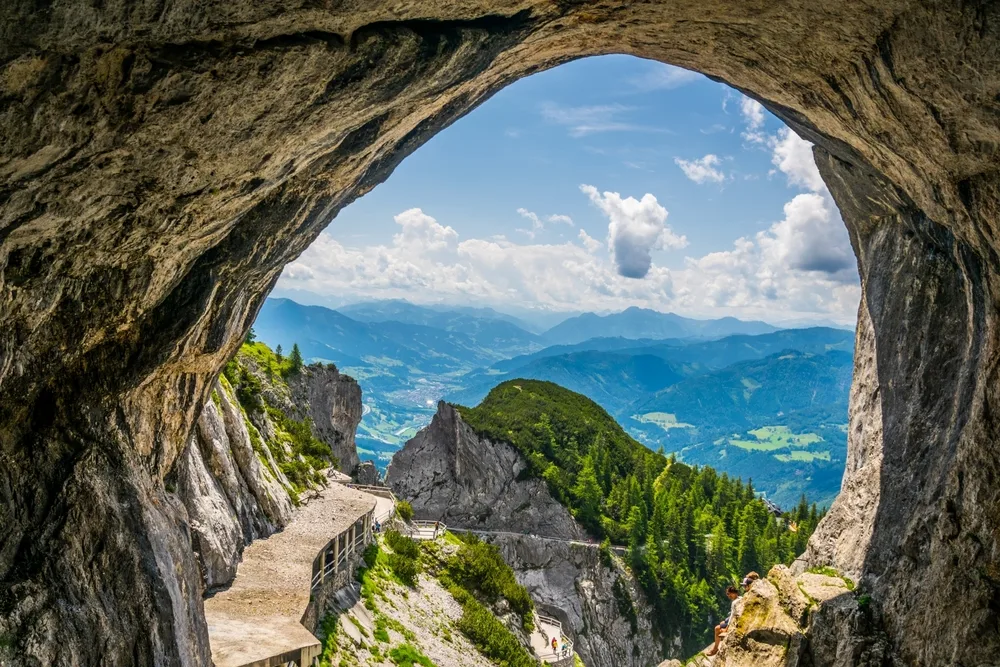
Trabantos/Shutterstock
Interested in seeing the world’s largest ice cave? That’s Eisriesenwelt Cave in Werfen, Austria (south of Salzburg). It’s cold inside, torches and lamps will light your way, and it’s a once-in-a-lifetime experience.
You’ll take a cable car ride to reach the cave before your official tour begins (grab the Combi ticket to get entry for both). Everyone’s issued a historically-accurate lamp for the tour while magnesium lights and carbide lamps create a beautiful glow inside.
As the world’s largest and longest ice cave, Eisriesenwelt Cave drills about 26 miles into the Earth with amazing twists, turns, and geological formations.
You’ll climb 700 steps inside the cave to reach the highest point, so make sure you’re up for a more challenging hike with ascents and descents. Warm clothing is required — it’s an ice cave, after all!
Tours are offered between April and October. Tickets sell out quickly, so book ahead of time to ensure your spot. You can expect your tour and visitor center visit to take just over an hour to up to 3-4 hours.
17. Schönbrunn Palace
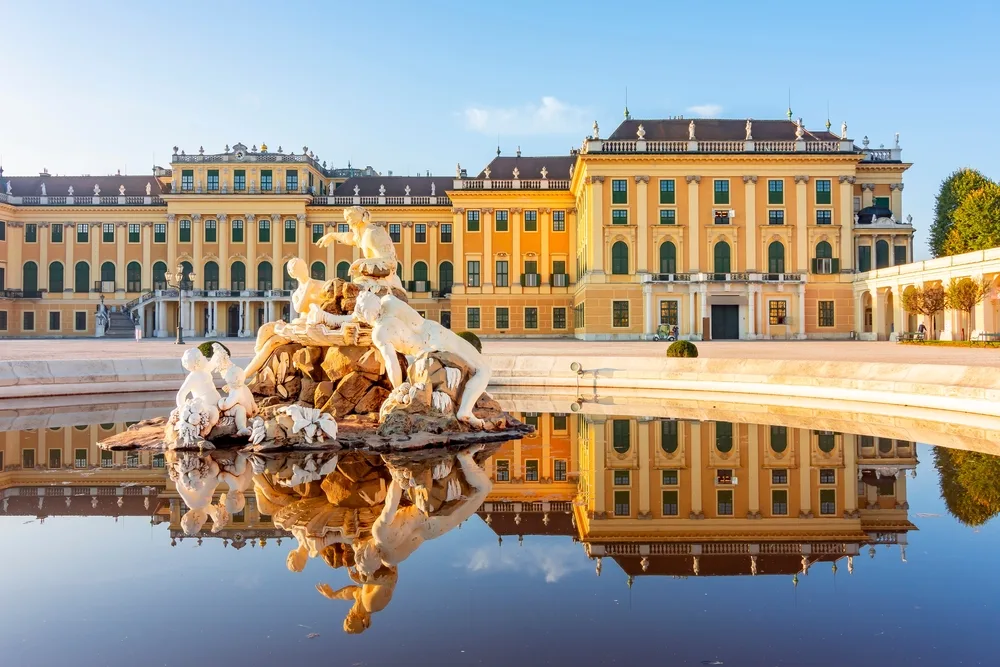
Vienna, Austria – October 2021: Schonbrunn palace in Vienna/Mistervlad/Shutterstock
The Schönbrunn Palace is an amazing look at luxury and 17th-century Imperial opulence in Vienna. The palace features 1,400 rooms and venues for concerts, events, and gallery exhibitions.
You can tour 45 of the rooms inside the palace with an audio guide or official guide. Stunning fountains and gardens outside don’t prepare you for the level of ornate detail and finery inside the palace.
Amazing ceiling frescoes, gold details, and a massive footprint make this Baroque-style palace beyond iconic. It’s so decorative and intricate that your eyes struggle to take in all the detail at once.
There are few different tours offered: 60-minute Grand Tour (all palace apartments and reception rooms), 40-minute Imperial Tour (private apartments and south reception room), 20-minute State Apartments tour, or the 60-minute guided Maria Theresia tour.
Tours are offered daily between 8:30am and 5:00pm and tickets must be purchased in advance to secure your spot.
Frequently Asked Questions
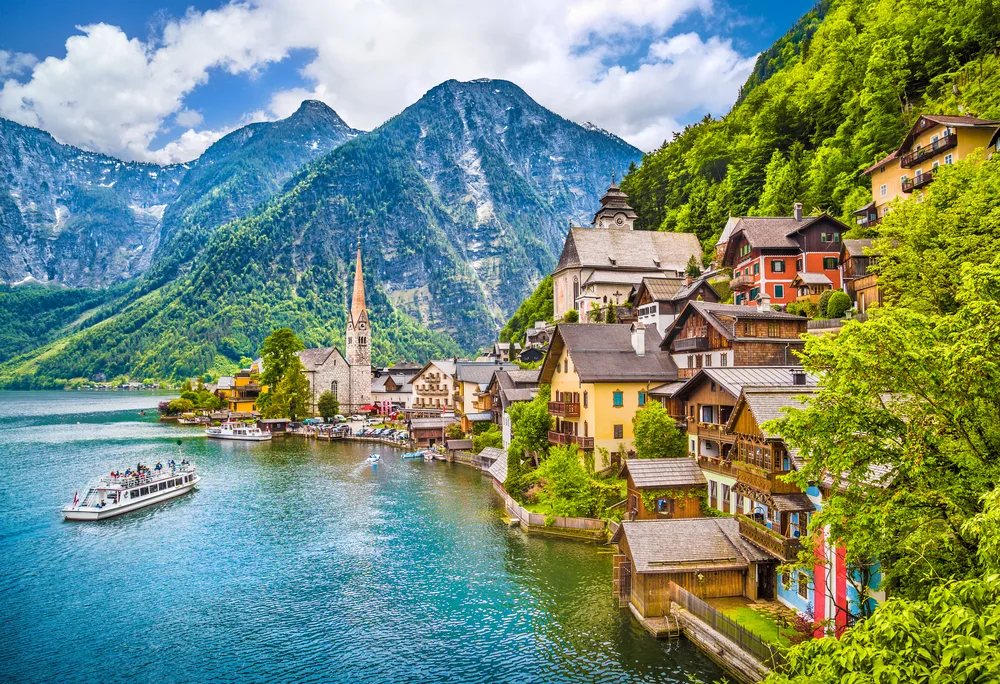
Canadastock/Shutterstock
With the best places to visit in Austria fresh in your mind, take a look at some of the most frequently asked questions other travelers had about planning a trip to learn more!
What is the most beautiful place in Austria?
The most beautiful place in Austria is subjective, but many consider Vienna, Innsbruck, Alpbach, and Salzburg (where the Sound of Music was filmed) to be among the most gorgeous spots.
Some of the most beautiful things in Austria are its historic architecture, opulent Baroque palaces, Medieval castles, stunning mountain and alpine lake scenery, and charming wood-crafted village homes in mountainside meadows.
Should I go to Vienna or Salzburg?
Between Vienna and Salzburg, Vienna is bigger, busier, and offers more culture, architecture, and history. Salzburg is smaller, more charming, scenic, and focused on the arts.
If you can, visit both Vienna and Salzburg. But if you can only choose one, seasoned travelers recommend Salzburg over Vienna for its picturesque views, castles, and alpine scenery.
What are the three famous cities in Austria?
Vienna, Salzburg, and Innsbruck are widely regarded as the 3 most famous cities in Austria. Vienna is the country's capital, while Salzburg is known as the birthplace of Mozart and filming location for the Sound of Music.
Innsbruck is the capital of the Tyrol province in Austria and is a popular ski and winter destination in the Alps. It offers great views of the mountains and outdoor recreation options.
How many days should I spend in Austria?
Austria has so much to see and do that you'll need to spend 10-14 days in the country to do it justice. You’ll be able to explore some of the major cities and also spend time in the gorgeous countryside.
Plan out an itinerary and research train routes to make your travels across Austria more efficient. You'll be able to fill up each day with fun activities, sightseeing, and exploration this way.
What is a good month to visit Austria?
April and May are good months to visit Austria with a balance between nice weather, open access to mountain regions and roads, and smaller crowds ahead of the peak summer season.
In Vienna, for example, April and May see highs between 61-69F with lows around 42-50F. Rainfall is regular, but not constant, and cloudy skies are a small tradeoff for shorter lines and smaller crowds.
So, What Area the Best Places to Visit in Austria?
The best places to visit in Austria offer amazing variation and a range of experiences that ensure you’ll never be bored in this scenic country. From Imperial palaces and historic cities to alpine countryside and charming mountain villages, there’s a lot to see and do in Austria.
Touring and exploring the capital, Vienna, will give you the most diverse experience with plenty of culture, dining, history, and entertainment options.
But if you’re looking for an outdoorsy getaway, head up into the Alps for skiing, hiking, biking, or climbing in places like Innsbruck, Klagenfurt, and Krimml.
No matter what’s on your itinerary, if you make sure to mix in a few destinations from this list, you’ll be able to experience the best Austria has to offer — and maybe you’ll hear the hills alive with the sound of music while you’re there. Happy travels!



